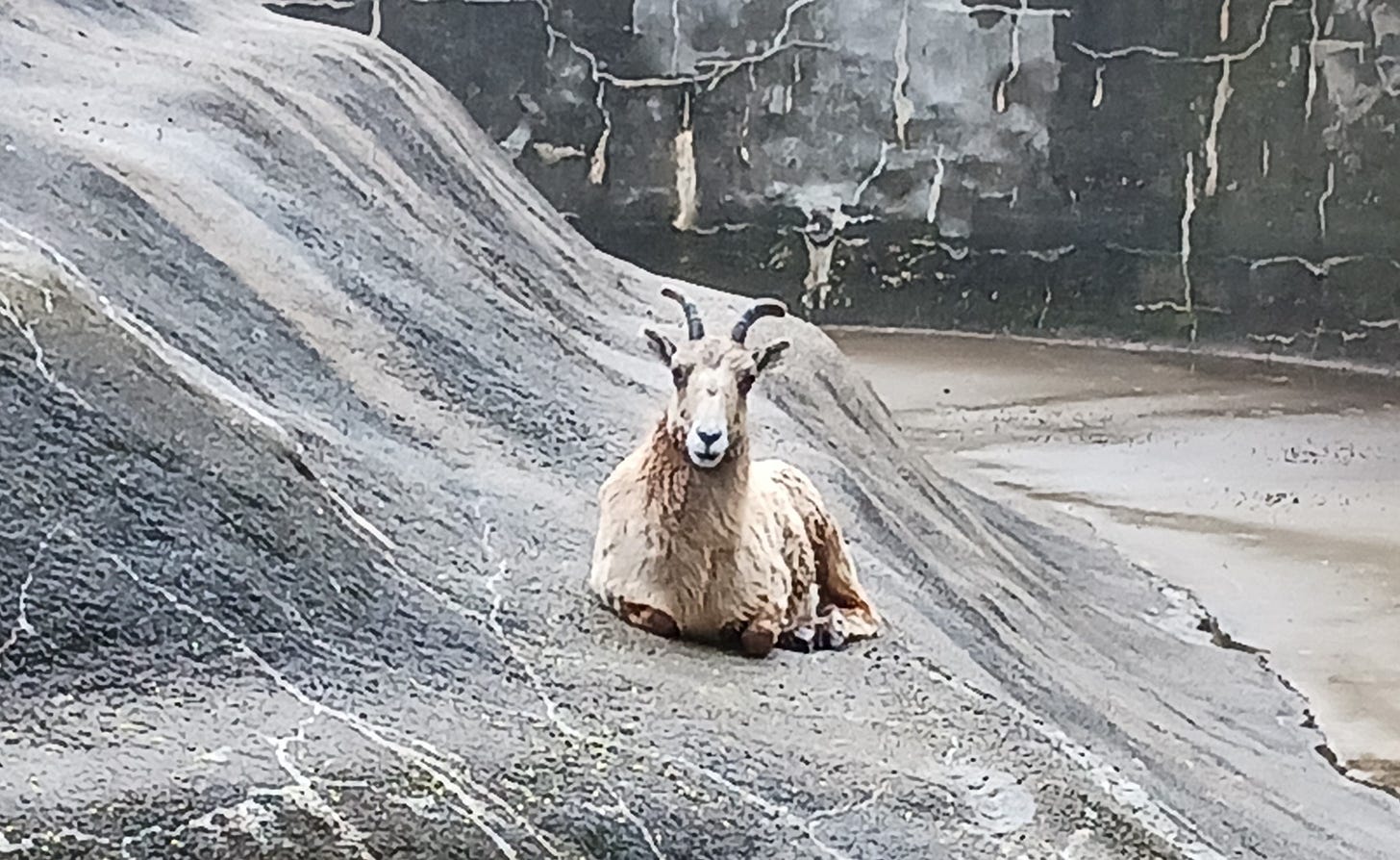Rocky Mountain Bighorn Sheep; photo by author
Staring out at a lawn that desperately needs mowing, stymied by persistent rain, I am challenged by the notion of staying in one place for a long period of time. There are a great many exquisite sites to see on this planet, and very little time to see them. Not only are our lives so infinitesimally short in the cosmic scheme of things, but our species is intent on rapidly destroying all that is truly wondrous in its endless pursuit of vacuous materialism.
I recall one of the first mountain ranges I ever laid eyes upon—the Rocky Mountains of North America. Mountainous regions are an extraordinary genre of ecosystem, majestic to look upon, life-changing to visit, and harsh to live in.
Like many mammalian species, mountains come to life through profound trauma and mature into magnificent, but often dangerous, works of art. Largely inhospitable to 21st century Eloi, the terrain of the upper crusts of the globe is practically alien. Surviving there requires preternatural cunning and endurance.
Creatures that can fly enjoy significant advantage, but that in no way makes life easy. Golden Eagles, one of the most feared avians of several mountain ranges, reach speeds of 150 mph to catch prey that they can see over vast distances. To evade the most observant targets, they use a “contour hunting” attack, which allows them to blend in with the horizon. Like a stealth jet, they swoop in and grab their meal with powerfully vicious talons before it even knows what hit it.
In some instances, the eagles engage in a mounted melee, where they simply land on the victim and fight it to do the death while riding it. This can include very large animals, such as a 100-pound (45 kg) deer. Golden Eagles must succeed in hunts several times a day if their young are to survive, which is why pairs will often work together. Some, like Alpine Eagles, team up to toss creatures to their deaths off cliff faces, then descend to the ground to collect their prize. It is a clever, if brutal, tactic.
Creatures bound to the ground must possess at least one of two critical attributes—superhero climbing ability or mythical resistance to fall damage.
Climbing skill is achieved through myriad ways. Some four-legged animals, like the various species of mountain goats (genus Capra), have cloven hooves often accompanied by calluses of an almost rubbery material that give them excellent grip.
Snow leopards have large, flat feet with fur on the underside to help grab precarious ledges. Their unusually large tail acts as a rudder and helps balance the cat during challenging or high-speed maneuvers. The muscles of most mountain dwellers are perfectly suited to conducting difficult leaps and maintaining balance even in complicated conditions.
Cats in general are equipped with—as one YouTuber put it—insane plot armor. Fall damage is just one arrow in a quiver stocked with them. Snow leopards are no exception. They can survive falls from heights often unscathed that would obliterate others. This is due to a number of factors.
When falling, many animals employ the aerial righting reflex, which is basically the foundation for the adage that “cats always land on their feet.” For cats specifically, their inner ears determine their orientation and position, allowing them to use their extreme flexibility to twist themselves mid-air to turn their feet toward the ground. Incredible reflexes allow this to occur almost instantaneously.
On higher falls, they will instinctively spread their body and limbs as a means to slow their descent by creating air resistance. This also distributes impact forces, which reduces the chance of injury. For example, ninety percent (90%) of cats brought to New York City veterinarians survived high-rise falls, with only about a third requiring medical intervention, according to a study in 1987. In 2012, Sugar the house cat survived a 19-storey fall in Boston with only minor bruising to her lungs.
He looks very much unconcerned about falling. Photo by author.
Snow leopards’ thick fur, fat stores, reflexes and agility, and hearty frames make them almost impervious to fall damage. Check out the video below from Wild Films India, in which the ghost of the mountains tackles a Bharal, and the two take a shocking tumble over hundreds of feet of protruding rocks. Not only did the feline survive, she successfully fed on the prey after regaining her composure.
Visit the mountains at least once in your life
I have had the good fortune of visiting several of the world’s great ranges, including the rooftop of the world—the Himalayas. Contrary to what many people today seem to think, especially the youth, you cannot respect their grandeur by looking at them on a phone or computer screen. Maybe you will not see any of the extraordinary creatures I outlined above, but a visit will benefit you regardless.
Until you breathe in the air, feel the chill, and experience your comparable insignificance, you will not know what it is that makes this planet truly remarkable.
A good friend of mine has written extensively on how we can experience the splendor of the mountains without mucking them up through laziness or ignorance. He provides tremendous insights for governments, tourism operators, and tourists themselves to enjoy the highlands in an ecologically wise manner. I highly recommend his work. (See here or here, or visit his website). After you read some, take the opportunity to go.
You only live once, so go live.
Happy hiking!
The Himalayas, from Nepal. Photo by author.
If you enjoyed this essay, consider giving it a like or Buying me A Coffee if you wish to show your support. Thanks.





